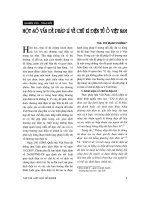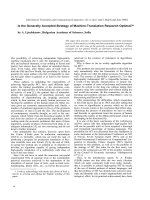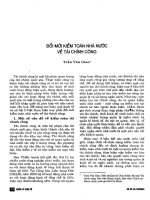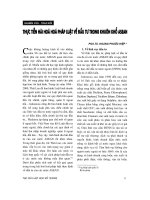Báo cáo môn Đầu tư tài chính Optimal Versus Naive Diversification: How Inefficient is the 1N Portfolio Strategy?
Bạn đang xem bản rút gọn của tài liệu. Xem và tải ngay bản đầy đủ của tài liệu tại đây (1 MB, 29 trang )
Optimal Versus Naive Diversification:
How Inefficient is the 1/N Portfolio
Strategy?
L P TCDN NGÀY – K22Ớ
NHÓM 20:
1.Tr ng Thúy Di uươ ệ
2.Tr n Th Bích Ki uầ ị ề
3.Nguy n Anh Vănễ
4.Huỳnh Quang S nơ
Abstract:
Target of the research: The objective in this
paper is to understand the conditions under
which mean-variance optimal portfolio models
can be expected to perform well even in the
presence of estimation risk.
Evaluating the out-of-sample performance of the
sample-based mean-variance portfolio rule and
its various extensions designed to reduce the
effect of estimation error relative to the
performance of the naive portfolio diversification
rule (1/N).
Using three performance criteria to compare:
+ The out-of-sample Sharpe ratio;
+ The certainty-equivalent (CEQ) return for the
expected utility of a mean-variance investor;
+ The t urnover ( trading volume) for each portfolio
strategy.
The 14 models are listed:
The 07 empirical datasets are listed:
Description of the Asset-Allocation
Models Considered
Definition:
+ R
t
: the N vector of excess returns (over the risk-free asset) on
the N risky assets available for investment at date t.
+ μ
t
(N dimensional vector): the expected returns on the risky
asset in excess of the risk free rate.
+ :the corresponding N×N variance-covariance matrix of
returns
+ The sample counterparts of μ
t
, given by and
+ 1
N
: N dimensional vector of ones.
+ I
N
to indicate the N × N identity matrix
+ x
t
: the vector of portfolio weights invested in the N risky assets
+ M: the length over which these moments are estimated.
+ T: the total length of the data series.
Almost all the models that we consider deliver portfolio
weights have the main difference is how to estimate μ
t
and
1. Naive portfolio:
The naive (“ew ” or “1/ N ”) strategy that we consider
involves holding a portfolio weight w
ew
t
= 1/N in each of
the N risky assets. μ
t
∝ 1
N
for all t.
2. Sample-based mean-variance portfolio:
Markowitz model (“mv”), the investor optimizes the
tradeoff between the mean and variance of portfolio
returns.
3. Bayesian approach to estimation error:
The estimates of μ and are computed using the
predictive distribution of asset returns. This
distribution is obtained by integrating the conditional
likelihood, f(R/μ, ), over μ and
with respect to a certain subjective prior, p ( μ, ).
3.1 Bayesian diffuse-prior portfolio:
If the prior is chosen to be diffuse, that is,
, and the conditional likelihood
is normal, then the predictive distribution is a
student-t with mean and variance
3.2 Bayes-Stein shrinkage portfolio (bs):
This model is designed to handle the error in
estimating expected returns by using estimators of the
form:
3.3 Bayesian portfolio based on belief in an asset-
pricing model (dm)
These portfolios are a further refinement of shrinkage
portfolios because they address the arbitrariness of the
choice of a shrinkagetarget, ¯μ, and of the shrinkage
factor, φ, by using the investor’s belief about the
validity of an asset-pricing model.
We implement the Data-and-Model approach using
three different asset-pricing models: the Capital Asset
Pricing Model (CAPM), the Fama and French (1993)
three-factor model, and the Carhart (1997) four-factor
model.
4. Portfolios with moment restrictions:
4.1 Minimum-variance portfolio (min)
4.2 Value-weighted portfolio implied by the market
model (vw)
4.3 Portfolio implied by asset pricing models with
unobservable factors (mp)
5. Shortsale-constrained portfolios
We have the sample-based mean-variance-constrained
(mv-c), Bayes-Stein-constrained (bs-c), and minimum-
variance-constrained (min-c).
To interpret the effect of shortsale constraints, observe
that imposing the constraint xi ≥ 0, i = 1, , N in the
basic mean-variance optimization, following
Lagrangian:
6. Optimal combination of portfolios
-
6.1 The Kan and Zhou (2007) three-fund portfolio (vm-min)
Estimation risk cannot be diversified away by holding only a
combination of the tangency portfolio and the risk-free
asset, an investor will also benefit from holding some other
risky-asset portfolio; that is, a third fund.
6.2 Mixture of equally weighted and minimum-variance
portfolios (ew-min)
This strategy is a combination of the naive 1/N portfolio and
the minimum-variance portfolio
Methodology for Evaluating Performance
Out-of-sample Sharpe ratio of strategy k
Certainty-equivalent (CEQ) return
Turnover
Results from the Seven Empirical
Datasets Considered
The 1/N strategy outperforms the sample-based mean-variance
strategy if one were to make no adjustment at all for the presence of
estimation error.
Bayesian strategies, explicitly account for estimation error, do not
seem to be very effective at dealing with estimation error.
About the portfolios that are based on restrictions on the moments of
returns (“min”, “vw” & “mp”)
Constraints alone do not improve performance sufficiently (“mv-c”,
“bs-c”)
Strategies combine constraints with shrinkage of expected returns are
more effective in reducing effect of estimation of error (“min-c”, “g-
min-c”)
dataset
Sharpe ratio: There is no single strategy that always dominates the 1/N
strategy
CEQ: No strategy from the optimal model is consistently better than
the benchmark 1/N strategy.
Turnover: Only the “vw” strategy is better than the 1/N strategy (hold
the market portfolios and does not trade at all)
Why the strategies from the various optimizing
models do not perform better relative to the 1/N
strategy ?
Following approach proposed by Kan & Zhou (2007)
The smallest number of estimation periods necessary for
the mv portfolio to outperform the 1/N
In which:
Is the expected loss from using a particular estimator of the optimal
weight
be the squared Sharpe ratio of the mean-variance portfolio
be the squared Sharpe ratio of the 1/N portfolio.
Observations
First, a large part of the effect of estimation error is
attributable to estimation of the mean
Second, and more importantly, the magnitude of the
critical number of estimation periods is striking.









